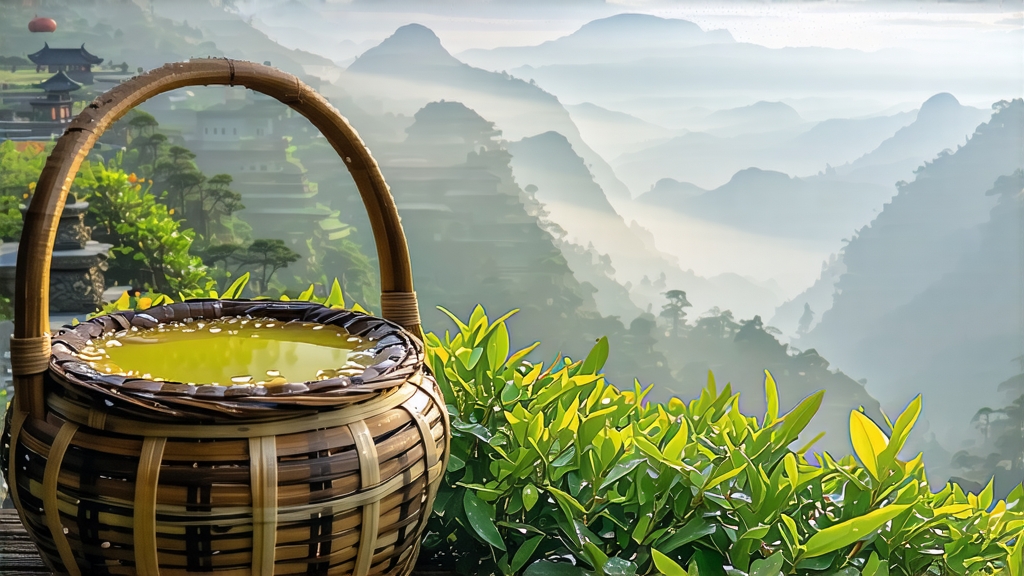
High in the mist-crowned ridges of Sichuan’s Ya’an prefecture, where the Min River carves granite gorges and evergreen mists rise like incense, the earliest spring buds of Camellia sinensis var. sinensis are coaxed into one of China’s most discreet aristocrats of taste: Meng Ding Huang Ya. Mentioned in Tang dynasty gazetteers and celebrated by Song poets, this “yellow bud” tea was once sealed in bamboo tubes and borne by fast horses to Chang’an’s palace gates, earning the phrase “the liquid jade that arrives before the swallow returns.” Today it remains the benchmark against which all other yellow teas are judged, yet outside China it lingers in the shadow of green and pu-erh fame. This essay invites the international tea traveler to discover why Meng Ding Huang Ya is worth the detour, from its courtly past to the microscopic choreography of its “sealed yellowing,” and finally to the quiet ritual of brewing it in a glass gaiwan while morning light drifts across the table.
History and Terroir
Legend places the first cultivation on Meng Ding mountain at 53 BCE, when the Daoist Wu Lizhen planted seven tea bushes that “did not wither in frost nor yellow in summer.” Whether myth or memory, the altitude (1,200–1,450 m), perennial cloud cover, and sandy loam rich in selenium create a slow-motion photosynthesis that concentrates theanine and aromatic esters. During the Tang, the tea was pressed into cakes for the Jiannan tribute route; by the Ming, loose-bud luxury prevailed. After a brief eclipse during the twentieth-century wars, a 1959 state initiative revived the cultivar, selecting the local “qunti zhong” seedling stock for its downy buds and low polyphenol astringency. The result is a tea that tastes like mountain air feels—cool, sweet, and faintly orchid.
Leaf Grades and Picking Calendar
Meng Ding Huang Ya is harvested only fifteen mornings each year, between the Qingming and Grain Rain solar terms when the dew still weighs down the neatest monocular bud or the bud-with-one-leaf shoot. Three grades are recognized:
• Imperial Sparrow Tongue: 100 % unopened buds, 1.2–1.5 cm, silvery down, yielding a liquor the color of chardonnay.
• Superior Flagrant Shoot: one bud clasping a partly opened leaf, giving a greener infusion but more floral lift.
• Fine Spring Fragrance: bud and first leaf of equal length, slightly later pick, prized for its balance of cream and green-bean notes.
Pickers wear cotton gloves to prevent bruising, and the leaf is carried in shallow bamboo trays lined with banana leaf so that no part exceeds 3 cm in depth—any pressure would trigger premature oxidation.
Crafting the Yellow: A Microbial Ballet
Yellow tea’s defining step is “men huang,” literally “sealed yellowing,” a slow enzymatic oxidation that occurs neither like green tea’s kill-green nor oolong’s torque-twist. Immediately after picking, the buds are spread 2 cm thick on bamboo trays and withered for 60–90 minutes at 26 °C; moisture drops from 76 % to 68 %, and grassy hexenals volatilize. Next comes three passes of hand-firing in a wok held at 140 °C, each lasting 4–5 minutes; the master’s palm hovers 2 cm above the leaf, judging by ear—the crackle should resemble rain on paper. While still at 50 °C, the tea is wrapped in stacks of steamed yellow paper, then buried under a hemp cloth “quilt” for 4–6 hours. In this sauna the leaf temperature hovers at 35 °C, encouraging endogenous peroxidases to nibble at chlorophyll edges, turning the leaf jade-yellow and freeing bound terpenes that smell of honeydew melon. A second, gentler firing at 90 °C sets the color and aroma, followed by another sealed rest—this cycle repeats three times until the master detects “the breath of apricot between thunder and rain.” Finally the leaf is dried over charcoal embers screened by bamboo mesh, reducing moisture to 5 % while imbuing a whisper of chestnut. The entire choreography spans 72 attentive hours; neglect for ten minutes can tip the batch into sourness or flatten it to generic green.
Chemistry in